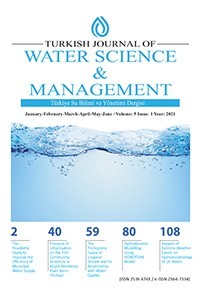Estimation of Glacial Rebound Effect by Vertical Velocity Analysis Method
Estimation of Glacial Rebound Effect by Vertical Velocity Analysis Method
___
- Bell, M., & Walker, M. J. (2014). Late Quaternary environmental change: physical and human perspectives. Routledge.
- Bradley, S. L., Hindmarsh, R. C., Whitehouse, P. L., Bentley, M. J., & King, M. A. (2015). Low post-glacial rebound rates in the Weddell Sea due to Late Holocene ice-sheet readvance. Earth and Planetary Science Letters, 413, 79-89.
- Clark, P. U., & Mix, A. C. (2002). Ice sheets and sea level of the Last Glacial Maximum. Quaternary Science Reviews, 21(1-3), 1-7.
- Garai, J. (2003). Post glacial rebounds measure the viscosity of the lithosphere. arXiv preprintphysics/0308002.
- Gasperini P, Sabadini R, 1990. Finite-element modelling of lateral viscosity heterogeneities and postglacial rebound. Tectonophysics, 179 (1–2): 141–149.
- Giunchi C, Spada G, Sabadini R, 1997. Lateral viscosity variations and post-glacial rebound: Effects on present-day VLBI baseline. Geophysical Research Letters, 24 (1): 13–16.
- Fjeldskaar W, 1997. Flexural rigidity of Fennoscandia inferred from the postglacial uplift. Tectonics, 16 (4): 596–608
- Kaufmann, G., P. Wu, and G. Y. Li 2000, Glacial isostatic adjustment in Fennoscandia for a laterally heterogeneous earth, Geophys J Int, 143(1), 262-273.
- Kaufmann, G., & Lambeck, K. 2000, Mantle dynamics, postglacial rebound and the radial viscosity profile. Physics of the Earth and Planetary Interiors, 121(3-4), 301-324. Lambeck, K., Smither, C., & Johnston, P. (1998). Sea-level change, glacial rebound and mantle viscosity for northern Europe. Geophysical Journal International, 134(1), 102-144.
- King, M. A., Altamimi, Z., Boehm, J., Bos, M., Dach, R., Elosegui, P., Fund, F., Hernandez-Pajares, M., Lavallee, D., Cerveira, P. J. M., Penna, N., Riva, R. E. M., Steigenberger, P., van Dam, T., Vittuari, L., Williams, S., and Willis, P. 2010, Improved Constraints on Models of Glacial Isostatic Adjustment: A Review of the Contribution of Ground-Based Geodetic Observations, Surv. Geophys., 31, 465–507, https://doi.org/10.1007/s10712-010-9100-4
- Peltier, W. R., and J. T. Andrews 1976, Glacial-Isostatic Adjustment .1. Forward Problem, Geophys J Roy Astr S, 46(3), 605-646.
- Lambeck, K., C. Smither, and M. Ekman 1998, Tests of glacial rebound models for Fennoscandinavia based on instrumented sea- and lake-level records, Geophys J Int, 135(2), 375-387.Lambeck, K., Esat, T. M., & Potter, E. K. (2002). Links between climate and sea levels for the past three million years. Nature, 419(6903), 199.
- Milne, G.A., J.X. Mitrovica, and D.P. Schrag, 2002. Estimating past continental ice volume from sea-level data. Quaternary Science Reviews, 21(1-3): 361-376.
- Paulson, A., Zhong, S., & Wahr, J. 2005. Modelling post-glacial rebound with lateral viscosity variations. Geophysical Journal International, 163(1), 357-371.
- Stockamp, J., Li, Z., Bishop, P., Hansom, J., Rennie, A., Petrie, E., ... & Ouwehand, L. 2015, Investigating glacial isostatic adjustment in Scotland with InSAR and GPS observations. In FRINGE Workshop, Frascati, Italy (pp. 23-27).
- Vermeersen L L A, Sabadini R, Spada G, 1996. Analytical visco-elastic relaxation models. Geophysical Research Letters, 23: 697–700.
- Whitehouse, P. L. 2018, Glacial isostatic adjustment modelling: historical perspectives, recent advances, and future directions. Earth Surface Dynamics, 6(2), 401-429.
- Wu, P. 2005, Effects of lateral variations in lithospheric thickness and mantle viscosity on glacially induced surface motion in Laurentia, Earth Planet Sc Lett, 235(3-4), 549-563
- Zhong S, Paulson A, Wahr J, 2003, Three-dimensional finite-element modelling of Earth’s viscoelastic deformation: effects of lateral variations in lithospheric thickness. Geophysical Journal International, 155 (2): 679–695.
- ISSN: 2536-474X
- Başlangıç: 2017
- Yayıncı: Tarım ve Orman Bakanlığı Su Yönetimi Genel Müdürlüğü
Estimation of Glacial Rebound Effect by Vertical Velocity Analysis Method
Household Wastewater Discharges Into The Rural Alabama & Impact on Watershed Water Quality
MODELING OF FLOODS IN GÜVENÇ BASIN, ANKARA USING HEC-HMS
Testing of Water Quality Model SISMOD in Alaşehir Creek Sub-basin
Natural Background Concentrations Determination for Metals in Surface Waters, Gediz River Basin
Betül Hande GÜRSOY HAKSEVENLER, Elif ATASOY AYTIŞ, Mehmet DİLAVER, Elif KÜÇÜK, Tolga PİLEVNELİ, Ülkü YETİŞ, Aybala KOÇ ORHON, Esra ŞILTU
